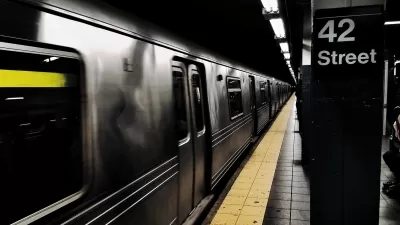Editorializing on the expected fare increase for New York City's 8.5 million transit riders, the Times suggests ways to soften the blow. Writing in response, the president of the Citizens Budget Commission suggests looking toward motorists.
The proposed fare increases would not just affect New York City's buses and subways but also the two commuter railroads, Metro North and the Long Island Rail Road, and also the tolls on the seven bridges and two tunnels managed by the Metropolitan Transportation Authority (MTA).
The editorial and letter to the editor present different farebox recovery figures for the country's largest and most-used transit system.
Per the Oct. 13 editorial, "New York subway riders, for example, contribute 72 percent of the cost of their commute, compared with 53 percent in Chicago and 34 percent in Atlanta". Carol Kellermann, President of the Citizen's Budget Commission, writes in her Oct. 21 "Letter to the Editor", "transit riders now pay less than half the cost of their rides. By its own analysis, the M.T.A. recovers only 36 percent of its costs through fares systemwide."
The editorial suggests that MTA look toward the state to soften the fare increase, particularly on low income New Yorkers who can least afford the fare increase.
Ms. Kellermann suggests to increase the revenue the MTA already gets from those who drive.
"Rather than look for more state tax revenues, a better approach would be to seek a greater cross-subsidy from motor vehicle users, who benefit from the reduced traffic that mass transit makes possible. The M.T.A. already uses some of its toll revenue to cover mass transit costs, and it receives a portion of the license and registration fees the state charges drivers.
These sources and new ones, such as tolls to enter the central business district, are preferable on efficiency and equity grounds to relying on more general taxes or on fare increases above half the actual costs of providing a ride."
As for the actual toll and transit increases, MTA has four proposals for raising NYC bus and subway fares, with the first one to increase the present $2.25 fare to $2.50. Public hearings begin on Nov. 7.
Thanks to New York Times Subway News Alerts
FULL STORY: EDITORIAL: Another Fare Increase?

Alabama: Trump Terminates Settlements for Black Communities Harmed By Raw Sewage
Trump deemed the landmark civil rights agreement “illegal DEI and environmental justice policy.”

Study: Maui’s Plan to Convert Vacation Rentals to Long-Term Housing Could Cause Nearly $1 Billion Economic Loss
The plan would reduce visitor accommodation by 25% resulting in 1,900 jobs lost.

Planetizen Federal Action Tracker
A weekly monitor of how Trump’s orders and actions are impacting planners and planning in America.

Federal Homelessness Agency Places Entire Staff on Leave
The U.S. Interagency Council on Homelessness is the only federal agency dedicated to preventing and ending homelessness.

Restoring Northern India’s Himalayan ‘Water Temples’
Thousands of centuries-old buildings protect the region’s natural springs and serve as community wells and gathering places.

Milwaukee to Double Bike Share Stations
Bublr Bikes, one of the nation’s most successful, will add 500 new e-bikes to its system.
Urban Design for Planners 1: Software Tools
This six-course series explores essential urban design concepts using open source software and equips planners with the tools they need to participate fully in the urban design process.
Planning for Universal Design
Learn the tools for implementing Universal Design in planning regulations.
Caltrans
Smith Gee Studio
Institute for Housing and Urban Development Studies (IHS)
City of Grandview
Harvard GSD Executive Education
Toledo-Lucas County Plan Commissions
Salt Lake City
NYU Wagner Graduate School of Public Service



























